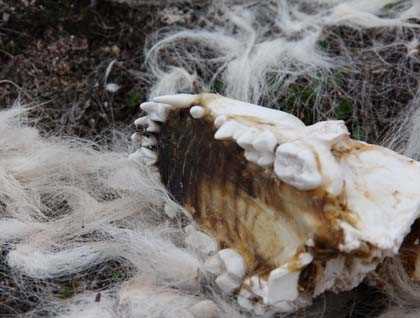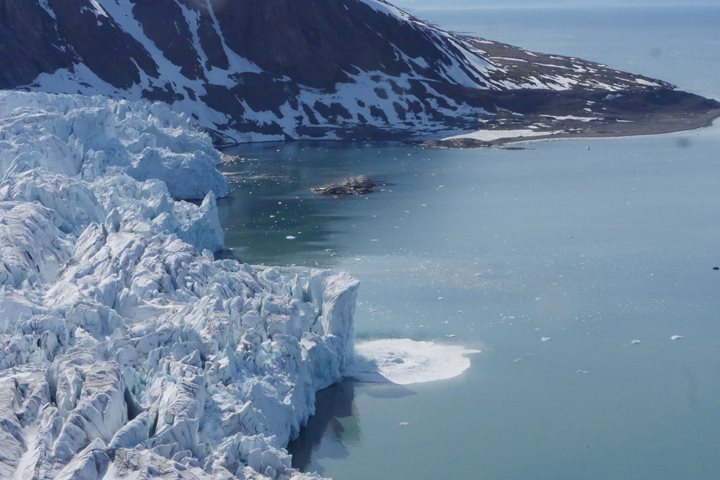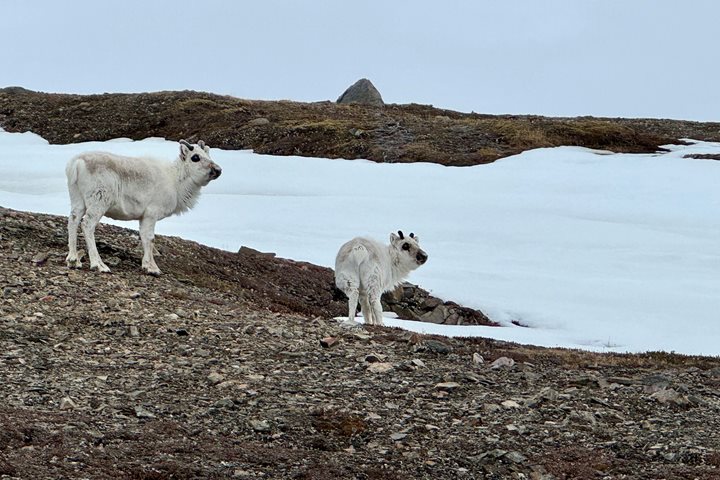Overnight we traveled south below 80°N to northwestern Spitsbergen. We went to shore at Sjovaernbukta in Bockfjorden, a branch of Woodfjorden (named for the abundant drift wood carried by the currents). Travelers were given many options for adventure including hikes or a Zodiac cruise. On a long hike, a dead polar bear was found. Ship naturalist, Kenneth Monsen, called in the tag found on the remains to the leading polar bear researcher at the Norwegian Polar Bear Institute, John Aars, to report the find. Aars suspected the cub died before the age of 10 months. The cub’s mother’s remains had already been found through her satellite collar.
Eleven-year-old Dash said, “On the short hike, we saw the national flower, the Svalbard poppy, and a member of the blueberry family, the bell heather. Our terrain was mossy with lots of vegetation, not many streams, and no trees. We spent time looking at wildlife as well as plants close to us and on the ground and lichen. The orange lichen can help determine the age of the rock. We found various reindeer antlers, a reindeer jaw (teeth ground down because of the pebbles they chew on while gathering their food), and a pile of bird bones, including the backbone. Upon returning from the hike, we took a Zodiac with Joe McInnis, to join Lisa, the underwater specialist, and the ROV. We were fortunate enough to experience driving the ROV 70 feet below the ocean. The ocean floor was soft like jelly. A problem we encountered was sand bunching up making the wildlife hard to spot. The trick was to let the ROV drop to the ocean floor naturally. It was quite simple to control, like a large video game.” With excitement, Jacob (age 7) agreed. He said, “When I drove the ROV, I got into a cloud of doom that kicked up sand and had to pull the ROV back up.”
The guests on the Zodiac cruises sighted a lot of pink-footed geese. These geese make holes in the mossy tundra, which looked similar to the mark made by a hiking stick. Hikers saw hundreds of these holes while they walked across the glacial moraine. Alex (age 13) remarked, “The moss is amazing that it can survive in such a harsh environment. It has a lot of perseverance.”
We travelled next to Fuglefjord, in the northwestern corner of Svalbard, a beautiful fjord surrounded by vast blue glaciers flowing around dramatic mountains. Minke whales swam alongside the National Geographic Explorer as we entered the fjord and small flocks of Atlantic puffins and little auks (dovekies) flew in the wake of the ship. Patton Small (age 18) commented, “The motion of the minke whales was quite enchanting.” We dined next to a magnificent glacier at the bottom of the fjord and watched as it calved icebergs into the Norwegian waters. Inspired by the epic events of our journey, the ship’s videographer invited us all to the bow of the ship to film us singing the National Geographic theme. And finally, at midnight, the sun made its first appearance of the week.
Joke of the day: “What do you get when you cross a dog with a plankton?” (answer: Fidoplankton)
Written By Alexandra Tsai (13), Dash Tsai (11), Jacob (7), Patton Small (18), Amy Lake, Sue Pike, Rona Zollinger (Grovsenor Teacher Fellows).






